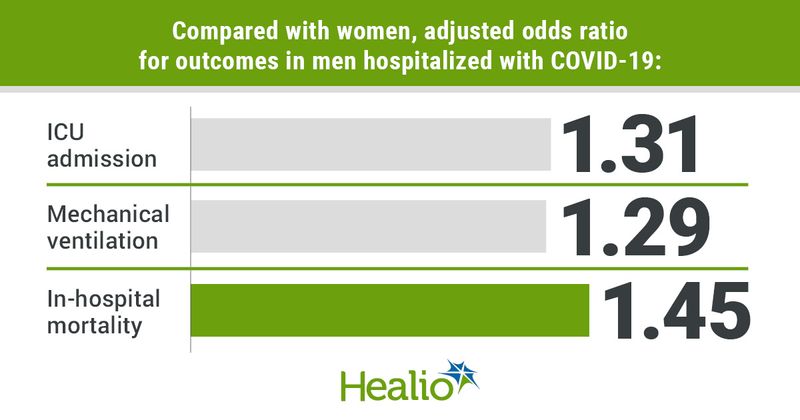Men more likely to test positive for COVID-19, have worse outcomes
Men are more likely than women to test positive for COVID-19, and to require ICU admission, mechanical ventilation and in-hospital mortality with the novel coronavirus, according to research published in PLoS One.
“While gender-related behaviors such as smoking, drinking, the propensity to seek hospital care and presence of comorbidities could affect the outcome of COVID-19, the increased risk of death seen in males across several different cultures in the world point to biological risk determinants,” Farhaan S. Vahidy, PhD, MBBS, MPH, FAHA, associate director of the Center for Outcomes Research at Houston Methodist, and colleagues wrote. “Despite these preliminary studies, a comprehensive analysis of sex differences in the epidemiological features of COVID-19 disease from a large and diverse United States metropolitan area is lacking.”

Vahidy and colleagues conducted a cross-sectional analysis of data from an observational research registry of patients with COVID-19 who sought care within the Houston Methodist health system. The registry collects data on patients’ sociodemographic factors, clinical information, comorbidities and outcomes.
Adults who tested positive for SARS-CoV-2 with polymerized chain reaction tests from March 6, 2020, through August 22, 2020, were included in the study.
Among 96,473 patients, 14,992 tested positive for COVID-19 during the study period. Of those patients, 31.9% were hospitalized and 9.5% died.
The researchers found that the proportion of male patients who tested positive (17.0%; 16.6–17.3) was higher than the proportion of female patients who tested positive (14.6%; 14.3–14.9) (OR = 1.20; 95% CI, 1.16–1.24). After adjusting for age, race, insurance type, income, BMI, smoking status and comorbidities, Vahidy and colleagues found that men remained significantly more likely than women to test positive for SARS-CoV-2 (aOR = 1.39; 95% CI, 1.33–1.45).
Of patients who were hospitalized, 30.9% were managed in the ICU. According to the researchers, the proportion of male ICU patients (34.1%; 32.2-36) was significantly higher than females (27.6%; 25.8–29.5) (OR = 1.36; 1.20–1.53). This finding, they determined, remained similar after adjustments (aOR = 1.31; 95% CI, 1.13–1.51).
Vahidy and colleagues found that the proportion of men hospitalized with COVID-19 who required invasive mechanical ventilation (19.0%; 17.5–20.6) was significantly higher compared with women (14.7%; 13.3–16.2) (OR = 1.36; 95% CI, 1.17–1.59). The proportion of men remained significantly higher after adjustments (aOR = 1.29; 95% CI, 1.08–1.55).
The proportion of patients who experienced in-hospital mortality was also significantly higher among men (11.6%; 10.4–13.0) compared with women (8.3%; 7.3–9.6), (OR = 1.44; 95% CI, 1.18–1.75), and this remained significant after adjusting for sociodemographic characteristics, comorbidities and other factors (aOR = 1.45; 95% CI, 1.06–2.00).
Vahidy and colleagues wrote that the study “demonstrates a higher risk for SARS-CoV-2 prognosis and severe COVID-19 outcomes among males and underscores the importance of further investigating the biological pathways that may influence disease etiology.”
“Sex is increasingly recognized as a modifier of disease, and its role with respect to SARS-CoV-2 and COVID19 appears to be no exception,” they wrote.
They added that while “distinctions in the immune response may constitute one explanation for sex-specific differences, further study is warranted to identify more robust strategies for patient risk stratification and targeted treatment intervention.”

